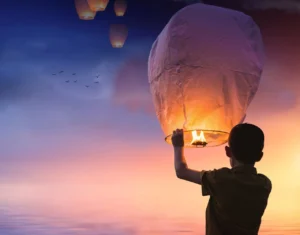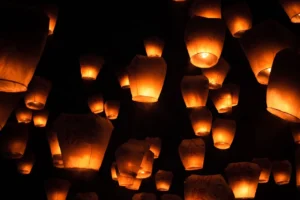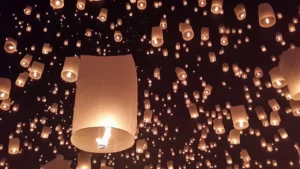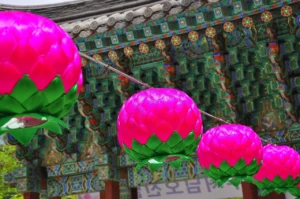Asian Lantern Festival
 |
| Image by Vuong Viet from Pixabay |
What is the Asian Lantern Festival ?
Guys, what do you think? is it only a festival? No, the Asian Lantern Festival is so much more than a festival. it’s an illuminating experience of light, hope, and humanity spanning across Asia every night.
To be honest, Centuries ago, it started as a simple tradition where people lit lanterns to honor their ancestors, guide lost spirits, and welcome good fortune. But it became something much larger over the years, a glittering festival that casts whole cities in golden light, in crimson blooms and soft amber flame.
Small children carry small paper lanterns. and their faces are lit up in amazement. Or old men muttering blessings as flames wisps within silken shells.
And Lovers release sky lanterns in concert, and the two sets of eyes watch them float up, dreams sprouting wings.
The History and Legend Behind the Asian Lantern Festival
Do you know ? The Asian Lantern Festival has its roots in ancient China, when the lights were first created over 2,000 years ago and are attributed to the Han Dynasty. And it began as a night of reverence, when a Buddhist monk lit lanterns to pay tribute to the Buddha and give compassion through light. So that's the very first thing, how it started.
And Hundreds of villagers soon joined, turning the night into a thousand burning whispers.
By the way, some think an emperor declared it a holy night later to please the gods and banish darkness.
But the festival evolved and expanded over the centuries, traveling to Japan, Thailand, Vietnam, and Korea. And each land stitches its own myth of hope and renewal into the year, like a darkened tapestry of warm, glowing ambience under a night sky..
The significance and symbolism of the Asian lantern festival
The Asian Lantern Festival carries a lot of meaning, centered on light, rebirth, and spirituality. And every lantern symbolizes the human desire to banish darkness, including our own.
And when a lantern is lit, it’s a silent prayer for peace, love, and happiness, for loved ones who have passed on. Most of them believe that it represents releasing all that pain and embracing new beginnings. That the light of each soul is unique, and together they bring harmony.
But spiritually, it symbolizes the victory of light over darkness and hope as a flame that can still last despite any amount of darkness...
 |
Image by NoName_13 from Pixabay |
How it's celebrated across Asia
Across Asia, the Lantern Festivals are celebrated in unique and mesmerizing ways. Each reflects the soul of its culture. In China, cities are alive with bright lantern fairs and dragon dances. And their temples are glowing, and families gather to eat sweet rice dumplings called tangyuan. And it's showing like unity and their togetherness.
And in Japan, rivers fill with floating lanterns during Toro Nagashi. And guiding ancestral spirits back to the heavens. You know the Japanese are always a bit different from how they do things.
However, Thailand transforms its night sky with thousands of floating lanterns during Yi Peng and Loy Krathong, creating a sea of stars above.
But in the Vietnamese and Korean communities, they are the same as them. They celebrate the festival with colorful lantern parades, prayers, and songs, blending devotion with joy.
Modern-day lantern festivals around the world
In the present, the Lantern Festival has crossed oceans. I meant becoming a global celebration of light and unity. Who doesn't like the beauty of night? In modern China, grand lantern exhibitions fill cities like Beijing and Shanghai, where towering silk dragons and glowing lanterns are on display. That attracts millions of people.
Meanwhile, Japan’s summer Obon festivals still send lanterns drifting on rivers. And while Thailand’s Yi Peng in Chiang Mai draws travelers worldwide to release sky lanterns together in breathtaking harmony.
And Beyond Asia, cities such as Sydney, New York, and Toronto now host their own lantern festivals. They blend art, technology, and tradition with dazzling light shows and cultural performances.
However, these modern events have become symbols of peace and shared humanity. And reminding people everywhere that, no matter where they live or what language they speak. The gentle light of a lantern still carries the same message, guys. It could be hope, remembrance, and the beauty of togetherness.
Best places and dates to experience lantern festivals
China
The most beautiful Lantern Festivals in China take place on the 15th day of the first lunar month, as they say.
And it usually falls in February. Cities such as Beijing, Nanjing, and Xi’an organize grand celebrations with glowing lantern fairs.
And dragon dances, and ancient streets bathed in golden light.
Believe me, it's damn beautiful. It marks the finale of the Lunar New Year, when families come together under a sky filled with color and warmth.
 |
Image by Thanh Tuấn Tạ from Pixabay |
Taiwan
The Pingxi Sky Lantern Festival is one of the most magical experiences in the world. Held every February, thousands of sky lanterns are released into the dark night, carrying wishes, prayers, and dreams high above the mountains. It is a breathtaking sight that symbolizes hope and renewal.
 |
| Image by Vuong Viet from Pixabay |
Thailand
In Chiang Mai, the Yi Peng and Loy Krathong Festivals light up the skies and rivers every November. Sky lanterns float upward while small candle-lit offerings drift along the water, creating a serene and spiritual glow that feels almost otherworldly.
 |
| Image by xiaolinzi821 from Pixabay |
Japan
The Obon Lantern Festival in August is a time of remembrance and reflection. Lanterns are floated on rivers to guide ancestral spirits back to the heavens. The atmosphere is peaceful, filled with music, dance, and quiet emotion.
 |
| Image by Lili Shih from Pixabay |
Vietnam and Korea
Both countries celebrate their own lantern traditions around the Lunar New Year. In Vietnam, colorful lanterns decorate streets and rivers, while in Korea, the Lotus Lantern Festival honors Buddha’s birthday with vibrant parades and glowing lotus lights.
 |
| Image by Whoop005 from Pixabay |
Each of these celebrations, though unique in time and style, shares a single message: light always returns, no matter how dark the night may be.
How to Get There
China
Fly into major international airports such as
Beijing Capital International Airport (PEK), Shanghai Pudong International Airport (PVG), or Xi’an Xianyang International Airport (XIY). From there, local trains and metro lines take you directly to lantern festival areas and historical streets. Book travel early in February, as it coincides with Lunar New Year celebrations, and crowds are large.
Taiwan
The Pingxi Sky Lantern Festival is best reached through
Taipei Taoyuan International Airport (TPE). From Taipei, take a scenic train ride on the Pingxi Line to Shifen Station, where the festival takes place. The journey itself passes through lush hills and charming villages, adding a touch of magic even before the lanterns rise.
Thailand
For the Yi Peng and Loy Krathong Festivals, fly into
Chiang Mai International Airport (CNX). Most events take place near the Ping River and Tha Phae Gate. Hotels and tour operators often offer packages that include transport and lantern releases, but reservations should be made months in advance, as November draws thousands of travelers.
Japan
To experience Obon Lantern Festivals, fly into Tokyo (Haneda or Narita Airport) or
Osaka Kansai Airport (KIX). Many of the most scenic celebrations are held in Kyoto and Hiroshima, where rivers and temples host peaceful lantern-floating ceremonies. Trains via the Shinkansen (bullet train) make travel between cities effortless.
Vietnam and Korea
In Vietnam, fly into Hanoi or Hoi An, especially during the Lunar New Year (Tet). Hoi An’s ancient town is famous for its glowing lantern streets.
In Korea, arrive at
Seoul’s Incheon International Airport (ICN) and travel to Seoul or Gyeongju for the Lotus Lantern Festival, which usually takes place in April or May.
Food, Accommodation, and Transport
China
Do you know ? At the Lantern Festival in China, food has become part of the celebration itself.
And all Families and visitors enjoy tangyuan, which symbolizes unity and family harmony.
So I'm pretty sure if you hurry, you can be a part of the whole fantasy.
Remember that the Street vendors sell dumplings, skewers, and candied fruits under glowing lanterns.
And if you are looking for accommodation, you can stay in charming boutique hotels near historical areas in Beijing or Xi’an. traditional architecture meets modern comfort.
Getting around is easy with bullet trains, metros, and taxis, but expect large crowds in February, so guys plan ahead.
Taiwan
At the Pingxi Sky Lantern Festival, local food stalls fill the streets with the scent of grilled squid.And you can taste scallion pancakes, and bubble tea also.
And the town of Shifen offers cozy guesthouses and mountain-view inns, giving visitors an intimate view of lanterns lighting the night.
however travelers usually stay in Taipei and take the Pingxi Line train or join day tours that include transport, lanterns, and local guides also.
Thailand
In Chiang Mai, Yi Peng and Loy Krathong are celebrated with rich flavors. You can try Pad Thai, mango sticky rice, coconut desserts, and grilled meats fill the streets.
Tell me did you feel the flavor right ?
And riverside restaurants are offer romantic dinners with the view of floating lanterns.
Trust me its totally worth. Accommodation ranges from luxury riverside resorts to budget hostels inside the Old City. so you can choose what you prefer.
You can use Tuk-tuks, motorbikes, and songthaews also. Those are popular and affordable ways to explore.
But booking ahead in November is may essential, You know why because hotels fill up quickly during the festival.
Japan
The Obon Lantern Festival in Japan is both peaceful and deeply cultural.
you can savor yakitori, ramen, sushi, and matcha sweets while exploring local food stalls near temples.
Many travelers stay in ryokans, traditional Japanese inns with tatami floors and onsen baths for a truly authentic experience.
Getting around is smooth with Japan’s efficient train and subway system, especially with the JR Pass for unlimited travel between cities.
Vietnam and Korea
In Hoi An, Vietnam, the Lantern Festival brings a feast of pho, banh mi, spring rolls, and fresh tropical fruits. And lantern-lit cafes by the river create an unforgettable atmosphere.
And boutique hotels and riverside homestays provide warmth and charm. Pretty sure bicycles are the best way to explore the old town.
During the Lotus Lantern Festival in Korea, visitors can sample tteokbokki, kimbap, and hotteok pancakes at bustling street stalls.
Seoul offers every type of stay from luxury hotels near Jongno Temple to budget guesthouses in Myeongdong. Subways and buses make travel convenient and affordable.
Environmental and Cultural Awareness of Asian Lantern Festivals
The Lantern Festival, while beautiful, carries a growing responsibility to protect both the environment and the cultural heritage it represents.
Many countries have begun shifting from traditional paper lanterns with open flames to biodegradable or LED lanterns, reducing fire risks and pollution.
In places like Thailand and Taiwan, communities now organize cleanup drives after celebrations to ensure rivers and skies remain pure.
Culturally, the festival teaches deep respect for ancestral traditions, nature, and unity. Visitors are encouraged to honor local customs by dressing modestly, handling lanterns carefully, and joining rituals with mindfulness.
It’s not only about watching the glow but also understanding what it means: harmony between people and nature, gratitude for the past, and responsibility for the future.
True celebration comes when the light we release doesn’t harm the world we share, but instead reflects care, wisdom, and peace.
 |
| Image by Anna from Pixabay |
Fun Facts and Interesting Traditions
The Asian Lantern Festival is filled with fascinating customs that make each celebration unique and unforgettable.
In China, families solve clever riddles written on lanterns, a tradition known as Deng Mi that dates back over a thousand years. It is both playful and symbolic of enlightenment.
In Taiwan, couples write wishes on sky lanterns together, believing that shared dreams rise higher and come true faster.
In Thailand, releasing a lantern during Yi Peng is said to let go of bad luck, while floating a candle on the river during Loy Krathong brings forgiveness and peace.
In Japan, floating lanterns during Toro Nagashi honor ancestors and remind everyone of the beauty of remembrance.
Some modern festivals even feature massive lantern sculptures shaped like dragons, flowers, and mythical creatures, blending ancient art with modern creativity. Every glowing lantern tells its own small story of love, hope, and connection.
Conclusion
The Asian Lantern Festival is more than a celebration of light; it is a reflection of humanity’s shared longing for peace, renewal, and connection.
From the ancient streets of China to the rivers of Japan and the skies of Thailand, each lantern carries a story, a wish, and a heartbeat.
It unites generations, blending sacred traditions with modern wonder, reminding us that even the smallest flame can brighten the darkest night.
To witness this festival is to stand inside a living dream where faith meets art, and hope takes flight.
It teaches us to release what we hold too tightly, to believe in new beginnings, and to see beauty in every flicker of light.
No matter where it is celebrated, the message remains timeless and pure: light will always return, and with it, so will hope.
Frequently Asked Questions (FAQs)
1. What is the main purpose of the Asian Lantern Festival?
The festival celebrates light as a symbol of hope, peace, and the triumph of good over darkness. It also honors ancestors and marks the end of the Lunar New Year in many Asian cultures.
2. When is the Lantern Festival celebrated?
In most countries, it takes place on the 15th day of the first lunar month, which usually falls in February. However, in places like Thailand and Japan, related festivals occur in November and August.
3. Is it safe to release sky lanterns?
Many regions now use biodegradable or LED lanterns to prevent fires and pollution. Always follow local safety rules and participate in official, organized events.
4. Can tourists join the celebrations?
Yes. Visitors are warmly welcomed in countries like Thailand, Taiwan, and China. Tourists can light lanterns, join parades, taste local food, and enjoy cultural performances.
5. What should I wear to a Lantern Festival?
Dress comfortably and modestly. Lightweight clothing and comfortable shoes are ideal, as most festivals involve walking, dancing, and outdoor activities.
6. Are there entrance fees for Asian lantern festivals?
Some public festivals are free, while large exhibitions or organized lantern shows may require tickets. Prices vary by country and event scale.
7. What is the most famous Asian Lantern Festival in the world?
The Pingxi Sky Lantern Festival in Taiwan and the Yi Peng Festival in Thailand are two of the most internationally recognized events, attracting thousands of travelers each year.
8. Why are lanterns important in Asian culture?
Lanterns symbolize light, guidance, and the human spirit’s resilience. They are also seen as carriers of wishes, prayers, and blessings that rise toward the heavens.
9. How can I take part respectfully?
Show respect for local customs and the environment. Participate gently, avoid littering, and remember that for many locals, this festival is deeply spiritual.
10. What makes the Lantern Festival special?
Its beauty lies not only in the glowing lights but in what they represent: unity, remembrance, and the universal hope that no matter how dark the night may seem, light will always return.
Popular articles

